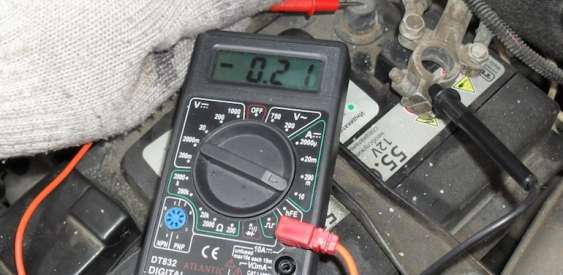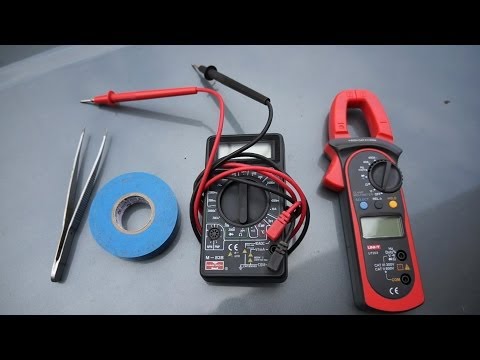
How to check the leakage current on a car?
Content
Checking the leakage current is required not only on cars with a long service life, but also on newer ones. From the fact that one morning the internal combustion engine will not be able to start due to a dead battery, those drivers who do not monitor the condition of the wiring, the connected consumers and the nodes of the on-board electrical circuit as a whole are not insured.
Most often, the problem of current loss / leakage appears in used cars. Due to the fact that our conditions, both climatic and road, lead to the destruction, cracking and abrasion of the wire insulation layer, as well as to the oxidation of the electronics connection sockets and terminal block contacts.
All you need to check is a multimeter. The task is, in order to identify by elimination a consumption circuit or a specific source, which even at rest (with the ignition off) drains the battery. If you want to know how to check the current leakage, what current can be considered the norm, where and how to look, then read the article to the end.
Such leaks in the car's electrical system can lead to rapid battery discharge, and in extreme cases, to a short circuit and fire. In a modern car, with many electrical appliances, the risk of such a problem increases.
Leakage current rate
In passenger cars a current leakage of 25-30 mA can be considered normal, maximum 40 mA. It is important to consider that this indicator is the norm if only standard electronics work in the car. When options are installed, the allowable leakage current can reach up to 80 mA. Most often, such equipment is radio tape recorders with a multimedia display, speakers, subwoofers and emergency alarm systems.
If you find that the indicators are above the maximum allowable rate, then this is a current leak in the car. Be sure to find out in which circuit this leak occurs.
Current Leakage Testers
Checking and searching for leakage current does not require any special equipment, but only an ammeter or multimeter that can measure direct current up to 10 A. Special current clamps are also quite often used for this.
Current measurement mode on a multimeter
Regardless of which device is used, before looking for a current leak in the car, turn off the ignition, and you must not forget to close the doors, as well as put the car on the alarm.
When measuring with a multimeter, set the measurement mode to “10 A”. Having disconnected the negative terminal from the battery, we apply the red probe of the multimeter to the terminal. We fix the black probe on the negative contact of the battery.
The multimeter shows exactly how much current is drawn at rest and it does not need to be reset.
Current Clamp Leakage Test
Current clamps are easier to use, because they make it possible to measure current without removing the terminals and without contact with wires, unlike a multimeter. If the device does not show “0”, then you need to press the reset button and take a measurement.
Using tongs, we also take a negative or positive wire into the ring and look at the current leakage indicator. the clamps also allow you to check the current consumption of each source with the ignition on.
Cause of current leakage
Leakage of current through the battery case
There are several reasons why current leakage can occur. The most frequent is neglected battery. In addition to contact oxidation, electrolyte evaporation often occurs in the battery. You can notice this by the moisture that appears in the form of spots along the joints of the case. Because of this, the battery can constantly discharge, so it is important to know how to check the battery leakage current, which will be discussed below. But besides the state of the battery on the machines, among the most common causes, one can note incorrectly connected devices (radio tape recorders, TVs, amplifiers, signaling), not included in the basic equipment of the car. They are relevant when there is a large leakage current in the car. But there are other places worth looking into as well.
Leakage of current in a car reasons has the following:
Contact oxidation is one of the common causes of current leakage.
- incorrectly connected radio power cable in the ignition switch;
- connection not according to the instructions of the DVR and car alarm;
- oxidation of terminal blocks and other wire connections;
- damage, bundle wires;
- melting of wiring near the internal combustion engine;
- short circuit of additional devices;
- sticking of the relay of various powerful electrical consumers (for example, heated glass or seats);
- a faulty door or trunk limit switch (because of which not only the signaling draws additional energy, but the backlight may also light up);
- breakdown of the generator (broken one of the diodes) or starter (short somewhere).
For everyday use of the car, leakage current is compensated by charging the battery from the generator, but if the car has not been used for a long time, then in the future, with such a leak, the battery simply will not allow the engine to start. More often, such a leak occurs in the winter, since at low temperatures the battery is not able to maintain its nominal capacity for a long time.
According to the recommendations of many experts, it is necessary to periodically check all electrical appliances in order to identify a possible current leakage in the car. And so, how to check the leakage current in a car?
How to find a leak
Checking current leakage by disconnecting fuses
It is necessary to search for current leakage in a car by excluding the source of consumption from the on-board network circuit. After turning off the internal combustion engine and waiting 10-15 minutes (in order for all consumers to go into standby mode), we remove the terminal from the battery, connect the measuring device in the open circuit. Provided that you set the multimeter to the current measurement mode of 10A, the indicator on the scoreboard will be the very leak.
When checking the current leakage with a multimeter, you need to monitor the indicators by removing all the fuse links from the fuse box one by one. When, when one of the fuses is removed, the readings on the ammeter drop to an acceptable level - this indicates that Did you find a leak?. in order to eliminate it, you should carefully check all sections of this circuit: terminals, wires, consumers, sockets, and so on.
Checking the current on the battery with a multimeter
Multimeter connection diagram
Even if, when checking the current leakage in a car with a multimeter, it seems to you that the data is slightly higher than normal, you should not ignore this, since the battery will begin to lose its charge capacity faster than it will receive from the generator, which will become more noticeable on short trips in urban areas. And in winter, this situation can become critical for the battery.
How to check current leakage with a multimeter and clamps is shown in the video.

Search for current leakage. Example
When checking the current leakage with a tester, it is necessary to trace in turn all possible leakage points, starting from non-standard devices, ending with places of possible wiring short circuit. The first step in checking for current leakage in a car is to inspect the engine compartment, and then move on to the instruments and wires in the cabin.
Checking the battery for current leakage
Checking the battery case for current leakage
There is an easy way to check the battery for current leakage. it is necessary to measure the presence of voltage not only at the battery terminals, but also on its case.
First, turn off the engine and connect the red multimeter lead to the positive terminal, and the black probe to the negative terminal. When switching the tester to the measurement mode up to 20 V, the indicator will be within 12,5 V. After that, we leave the positive contact on the terminal, and apply the negative contact to the battery case, in a place with a supposed spot from electrolyte evaporation or to battery plugs. If there really is a leak through the battery, then the multimeter will show about 0,95 V (while it should be “0”). By switching the multimeter to ammeter mode, the device will show about 5,06 A of leakage.
in order to solve the problem, after checking the battery current leakage, you will need to remove and thoroughly rinse its case with soda solution. It will clean the surface of the electrolyte with a layer of dust.
How to check the generator for current leakage
When no problems were found in the battery, then most likely there is a current leakage through the generator. In this case, in order to find a current leak in a car and determine the health of the element, you need to:
Checking the generator for current leakage
- connect the tester probes to the battery terminals;
- set the voltage measuring mode;
- start the internal combustion engine;
- turn on the stove, low beam, heated rear window;
- look at the score.
When checking for leakage, you can use a voltmeter. this method helps to identify problems in the generator as accurately as an ammeter. By connecting the contacts to the terminals, the voltmeter will show an average of 12,46 V. Now we start the engine and the readings will be at the level of 13,8 - 14,8 V. If the voltmeter shows less than 12,8 V with the devices turned on, or while keeping the speed at the level 1500 rpm will show more than 14,8 - then the problem is in the generator.
When current leakage through the generator is detected, the causes are most likely in broken diodes or a rotor coil. If it is large, about 2-3 amperes (when switching to the current measurement mode), then this can be determined using a conventional wrench. It must be applied to the generator pulley and if it is strongly magnetized, then the diodes and the coil are damaged.
Starter leakage current
Checking the starter for current leakage by disconnecting the power wire
It happens that when checking the current leakage on a car, neither the battery with the generator nor other consumers are the sources of the problem. Then the starter may be the cause of the current leakage. Often it is the most difficult to determine, since many sin immediately on the battery or wiring, and no one comes to mind to check the starter for current leakage.
How to find the current leakage with a multimeter has already been described. Here we act by analogy with the exception of the consumer. Having unscrewed the power “plus” from the starter, we remove it so that in order not to touch the “mass” with it, we connect to the terminals with the probes of the multimeter. If at the same time there was a decrease in current consumption, change the starter.

Checking the starter for current leakage
You can more accurately determine whether current is leaking through the starter with a current clamp. in order to check the leakage current with clamps, measure the wire of the negative terminal of the battery when starting the internal combustion engine. Having placed the tongs around the wire, we start the internal combustion engine 3 times. The device will show different values - from 143 to 148 A.
The peak value at the moment of starting the internal combustion engine of a car is 150 A. If the data is significantly lower than those indicated, then the starter is the culprit of the current leakage in the car. The reasons may be different, but it is definitely worth removing and checking the starter. Learn more about checking the starter in this video: